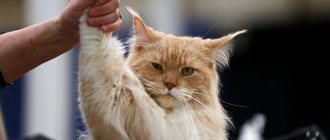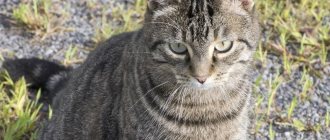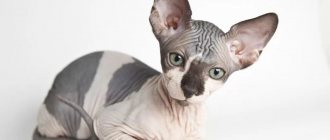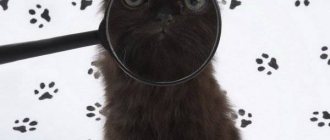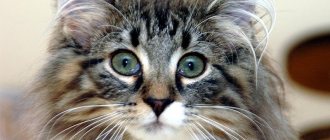The Munchkin cat breed is classified as rare and is little known in our country. The history of these cats began in 1983, when American Sandra Hochenedel sheltered a stray cat with unusually short legs. The woman thought that the animal was sick, that’s why it looked like that, but when this cat gave birth, the kittens had the same legs, and they were healthy, vigorous and felt great. This moment was equated with the emergence of the Munchkin breed.
From this story it is clear that these creatures did not arise as a result of targeted selection work, but as a result of natural mutations. Or rather, thanks to the achontroplosia gene, which is responsible for the short legs of not only munchkins, but also dachshunds and basset dogs.
The breed was officially recognized only in 1991. Its name is taken from the book “The Wizard of Oz”, as it called the little funny people who lived in the Blue Country. Since the gene turned out to be dominant, when crossing munchkins with other breeds, kittens were mostly born with short legs, so thanks to munchkins it was possible to develop many miniature breeds, for example, kinkalow, napoleon, bambino, lambkin, dwelf, dwarf minskin and others.
In America and Europe, short-legged cats became popular after one of them appeared on the cover of World Street Journal in 1995. These creatures were brought to Russia only in 2001.
Description of breed standards:
- the body is miniature, oblong, has a wide chest, these cats are one of the smallest breeds in the world, their weight varies from 2 to 4.5 kg;
- the head is wedge-shaped, flat forehead, high and prominent cheekbones, which are more pronounced in males;
- the ears are set high and wide, of medium size, have a wide base and taper at rounded tips; in long-haired representatives, tassels are possible;
- the eyes are distinguished by their almond shape, widely spaced from each other and at a slight slope relative to the ears, the color does not depend on the color;
- chin in profile aligned with nose, firm and strong;
- the muzzle is of medium length, with smooth shapes and protruding vibration pads;
- the nose has an average length, a slight deflection is acceptable;
- the neck is short, strong and muscular;
- the limbs are short, the hind legs may be slightly longer than the front ones, the paws are small and round, facing forward;
- the tail is of medium length, not thin, tapering and rounded at the tip;
- the muscles are well developed, stronger in cats than in cats;
- the coat can be long and short, in long-haired cats it is silky, with a moderate undercoat, with a beautiful fringe on the tail, in short-haired cats the coat is plush, shiny and elastic, with a medium undercoat, the colors are varied.
Munchkin feet have a classification based on their size:
- standard;
- short;
- rug hugger (extremely short).
Origin story
Stories about short-legged cats have been common since the late 19th century. What are there notes about in European publications of that time? The founders of the Munchkin breed are considered to be the cat Blackberry and her son Tulus.
A pregnant black cat with short legs was adopted by a resident of Rayville (Louisiana). This happened in 1983. The woman thought that the animal did not grow up due to poor living conditions, and out of pity she took her into the house. However, Ezhevichka’s litter also included short-legged kittens. One of them, Tulus, became the progenitor of all munchkins. Very soon there were a lot of short-legged cats in the town.
The name munchkin comes from the book The Wizard of Oz. This was the name of the fabulous squat people.
The Munchkin breed began its spread around the world in the USA. In 1991, she was officially presented at the TICA show. In 1995, the TICA (International Cat Association) standard was approved. Then the breed was recognized by WFF and WCF. These organizations allow only those animals that can provide a pedigree of at least 3 generations to become champions. Other systems classify short legs as a disease and do not recognize the breed for ethical reasons.
Dachshund cats arrived in Europe, in particular in France, in 1993, and at the same time in Japan and China. In these countries they immediately took first place in the top popular ones. In Hong Kong, munchkins were (and are) sold for $1,500. Residents fell in love with the breed for the minimum damage, because cats cannot jump high or far, which means they do not harm things.
In its reports, the Google search engine provides information that of all cat breeds, munchkins are the most frequently requested photo in New York. The first dachshund cat appeared in Russia in 2001.
How to choose the right kitten
For a small munchkin, it is better to contact a trusted breeder or a specialized nursery. At the time of sale, short-legged kittens must have documents confirming their breed membership and a veterinary passport with vaccination marks.
It is important to pay attention to the conditions of detention, appearance and behavior of the children. Short-legged cats should not have defects that are not allowed in the breed standard.
The health of munchkins can be judged by the absence of dirt under the tail, unpleasant odor from the mouth and scratching on the skin. The kitten should have clear eyes, clean ears and a soft belly.
On a note. A swollen belly is a sure sign that the animal is infected with helminths.
Kitten care
Caring for a little munchkin is no more difficult than caring for a kitten of any other breed:
- The short-legged pet is given some time to adapt to its new home and is shown where the bowls with food and water are.
- Also, the munchkin is immediately taught to use a scratching post, relieve himself in a litter tray, and play only with his toys.
- Since the short-legged kitten is very curious, wires, indoor plants, household chemicals, and small and fragile things are hidden from him.
- To avoid accidentally injuring your munchkin, before turning on the washing machine or oven, you must check to see if your pet is hiding there.
To avoid digestive problems, at first the short-legged cat is fed what it ate from the breeder. New foods are introduced into the munchkin’s diet gradually, carefully monitoring the reaction of his body.
The feeding schedule for a pet with short legs is developed taking into account the age of the ward:
- up to 3 months – 5 times a day;
- 4-11 months – 3-4 times a day.
One-year-old short-legged cats eat twice a day.
Feature of the breed
Breeders do not use drugs or any techniques that slow down the growth of animal limbs.
Munchkin is the result of a natural mutation. Man had absolutely no influence on the process of the appearance of the breed.
Dachshund cats are carriers of the hypochondroplasia gene, which prevents the limbs from developing properly, but does not affect the rest of the body. The dimensions of the head and body are normal and proportional. The mutation does not affect the musculoskeletal system. Arthritis, spinal problems, or walking problems are no more common in the breed than in other breeds as they age.
Munchkins give birth to both short-legged and non-standard kittens with long legs. Some limbs may be shortened by half, while others may be so short that shoulders and forearms cannot be distinguished. The latest kittens are classified as “Super Shorts” or “show quality”.
The shortest cat included in the Guinness Book is Lilieput, whose height (from floor to shoulders) was 13.34 cm. Lives in the USA, California.
Another feature of the munchkin is the habit of sitting on its hind legs like a meerkat. He can do this for quite a long time, observing what is happening. Moreover, unlike other cats, it sits on its hips and uses its tail to maintain balance. In this position, the front legs hang over the chest, which makes the cat look like a kangaroo.
Origin of the breed
Mentions of cats with short limbs have appeared since 1930. They were met in European countries and noticed in Soviet Stalingrad. In England, 4 generations of dwarf cats were bred, but by the end of World War II they disappeared and were remembered as kangaroo cats. The animals received this name for their ability to stand on their hips for a long time, with their front legs dangling in front of them, and to use their tail as additional support.
In 1983, a resident of the American state of Louisiana found and sheltered a stray short-legged cat on the street and named her Blackberry. The woman considered the non-standard length of the limbs to be the result of a hard street life, but the pet passed this sign on to the kittens. Now the Blackberry cat is considered the ancestor of short-legged cats.
In 1991, dwarf cats were first shown to representatives of the TICA felinological association, and 3 years later they were added to the list of new breeds.
The WCF organization recognized dwarf cats when scientists proved that the mutation occurred without human intervention and did not affect the health of the animals. Other international felinological organizations do not listen to the arguments of scientists and consider short legs to be a defect that reduces the quality of life.
Munchkins are bred in the USA, Japan, and remain rare in European countries. Nurseries operate only in Switzerland, France, and the Netherlands. The breed appeared in Russia in 2001; development began with the Hercules cat, imported from South Africa. Nurseries opened in Moscow, St. Petersburg, Novosibirsk.
During breeding work, cats with short limbs were crossed with representatives of other breeds, and new types arose:
- Napoleon is a hybrid with Persian and exotic cats;
- Skokum - with the La Perm breed;
- Mei-Toy - Singaporean and Ocicat cats;
- Kinkelow - American Curl;
- Bambino - with the sphinx;
- Elf - with curl and sphinx.
These species are recognized as hybrid breeds and are constantly being improved in nurseries. A group of enthusiasts are breeding Fold Munchkins by crossing them with Scottish Folds. International associations refuse to register them; they are considered carriers of a host of genetic diseases.
British Chinchilla
Maine Coon
Bambino
When crossing two short-legged individuals, some of the embryos die in the womb, and half of the kittens are born with limbs of normal size. Breeders involve long-legged munchkins in breeding work to preserve the breed; after mating with them, the litter increases by a quarter.
Exterior
Crossbreeding experiments have led to positive and negative consequences. The enrichment of the gene pool helped to strengthen the health of the breed and expand the range of colors. At the same time, breeders received different types of animals, and are now trying to even out the breed.
The body weight and height of animals vary:
- weight of males is 2 – 5 kg, according to the standard 3 – 4 kg;
- females weigh 1.5 – 4 kg, average 2 – 3.6 kg;
- the height at the withers ranges between 14 and 18 cm; the shortest cat in the Guinness Book of Records has 13.34 cm.
The breed standard was approved in 2007, but work on it continues.
Felinologists organize seminars and discussions with the aim of aligning the exterior, striving for the following external characteristics:
- The head is proportional to the body. The shape of the skull is wedge-shaped with soft rounded contours and wide, defined cheekbones. The flat forehead smoothly transitions into the bridge of the nose, where a slight deflection is allowed. The nose and firm chin lie on the same line.
- The ears are medium to large in size, set high and far apart. They are wide at the base, narrowing and rounded at the top. The edge runs along the contour; in semi-long-haired cats there are tassels at the ends.
- The eyes are almond-shaped, widely spaced, and lie at an angle to the base of the ears. The color of the iris is uniform, bright, and does not depend on the shade of the coat. White cats often have multi-colored eyes.
- The neck is muscular, of medium size, thicker in males, more graceful in cats.
- The body is elongated, 16–18 cm long, with developed muscles, strong bones, a rounded chest, and sometimes angular shoulder blades. The back slopes slightly from the tail to the shoulder blades due to the unequal length of the legs.
- The tail is of medium thickness and tapers towards the tip; in semi-longhaired cats it is fluffy. The length is proportional to the body; when moving, the tail is held vertically.
- The limbs are straight or slightly curved inward, ending in rounded compact paws. The average height is 13 cm, the forelimbs are shorter than the hind limbs, the upper and lower parts are the same length.
- The coat is short or semi-long, with a thick undercoat. The texture of short-haired animals is plush, while that of semi-long-haired animals is silky.
- on color ; any shades and patterns are allowed: plain, color-point, with markings. Silver and smoky cats are more common; a rare color is chocolate with a marble pattern.
Breeders consider a round head and eyes, and curly hair to be defects in appearance. A short, stocky body with a protruding chest and drooping croup, paws turned outward, and a sagging back are not welcome.
Character
The lively temperament of munchkins is evident from childhood. At first, the kittens’ paws do not hold on, they diverge to the sides, this does not prevent the animals from crawling. With age, the limbs become stronger and cats stand on their feet. They deftly control their paws, run nimbly, jump high for their height, and confidently climb vertical surfaces. If they don’t make it to the jump, they overcome the height in stages, showing resourcefulness and dexterity.
They love to play, excitedly chase a mouse on a rope or a laser beam, and gain decent speed in running and height in jumping. Pets do not stop having fun even at night, so toys are removed during sleep. Munchkins are famous for their ability to sit on their hind legs in an upright position, supported by their tail. In this position, the view expands, so it is more convenient to observe what is happening in the house or on the street through the window.
Animals have a stable psyche. They quickly adapt to unfamiliar surroundings, successfully withstand moving, traveling, being carried, and getting along with new people and animals. They love to communicate and play with their owner, but they calmly remain alone, do not get bored, and come up with activities themselves.
Owners notice that their pets have a tendency to collect things: animals hide objects in “hides” so that they can take them out and play later.
Munchkins can be safely left next to children; they become play partners, patiently endure excessive affection, and do not let out their claws. They do not show aggression towards other animals; they coexist happily with dogs, birds, and rodents. Cats are sometimes treated as competitors, but do not strive to lead; it will take time to get along with the new inhabitant of the house.
Munchkins rarely meow. In the USA, a case was recorded when the owner did not hear a sound from her pet for 5 years, until a second cat appeared in the house. Miniature cats know how to defend themselves. When meeting a strong opponent, they disorientate with non-standard sizes and actions, deftly wield their front paws and remain victorious.
Maintenance and care
Kittens are taken from their mother at 2–3 months, when they are ready for independent living. Before the pet arrives, they choose a place for a bed or a house nearby with people, and buy the necessary care items.
Short animals do not require space and multi-tiered play structures, and even a novice cat lover will be able to care for them:
- Bathing . Munchkins do not need frequent water treatments; the pet is washed 4-6 times a year. Shampoo is selected according to skin type and coat length. Before swimming, cotton swabs are inserted into the ears to prevent water from getting inside. The shampoo is applied from the shoulders to the tail in a circular motion: animals do not like to bathe, soaping against hair growth increases the discomfort. Do not wash your hair with shampoo, wipe it with wet hands. After bathing the pet, blot it with a towel and do not rub it. Use the hairdryer sparingly, leaving the hair slightly damp, otherwise the hair becomes brittle, loses its shine, and the skin flakes off.
- Grooming . Short-haired cats are brushed once a week. Dead hair is removed with a fine-toothed comb or a furminator against the direction of growth. Then collect hair from the surface with damp palms or a silicone glove. To enhance shine, the wool is wiped with a silk cloth or suede. Long-haired pets are combed every other day. First, use a wide-toothed comb to sort out knots and tangles. Then the excess undercoat is removed against the growth direction using a fine-toothed comb. Finally, brush the hair with a massage brush with natural bristles.
- Treatment of eyes and ears. Munchkins rarely notice problems with these organs. The eyes are wiped with a moistened gauze swab when discharge appears in the corners. The ears are treated once a week: carefully clean the inner surface of the shell from dirt and sulfur deposits with a cotton pad with a cosmetic solution.
- Paw care . The claws of short-legged cats do not interfere; they are treated to avoid accidental scratches. To grind off the upper stratum corneum, place a scratching post in a place convenient for the pet. Once a month, the claws are trimmed by 1 - 2 mm with a nail clipper, and uneven edges are processed with a file.
- Mouth hygiene . Munchkins are not prone to gum disease, they brush their teeth once every 2 weeks with a cat brush, and buy toothpaste at a pet store. Cats do not like the procedure, so the plaque is cleaned with quick movements for no longer than a minute.
- Toilet . The kittens remember the new toilet the second time and do not relieve themselves in the wrong places. The tray is chosen according to the pet’s height; if the sides make it difficult to climb inside freely, then choose a toilet with low walls.
Munchkins do not need walks, but they will happily walk down the street on a harness; they are not allowed out without supervision.
Health
Munchkins live 13–16 years, deviations up or down depend on care, nutrition, and living conditions. Animals do not suffer from genetic pathologies; they have strong immunity. The achondroplasia gene does not affect health: the joints remain mobile, do not collapse, and do not hurt.
Animals with short legs are sometimes diagnosed with lordosis - a curvature of the spine. The pathology develops due to weakening of the back muscles or damage to the vertebrae in the area of the shoulder blades. The ridge descends and puts pressure on the lungs, trachea, and heart, which disrupts their normal functioning.
In severe cases, heart and pulmonary failure develops, threatening the life of the animal. Some felinologists consider lordosis to be a characteristic genetic malfunction of short-legged animals, but the pathology also occurs in other breeds. Kittens with spinal problems do not survive, but the disease rarely develops.
To protect against infections, kittens are vaccinated, even if they do not leave the house. At 2 months, the first comprehensive vaccination is given to prevent viral diseases, and repeated 3 weeks later. A rabies vaccine is administered annually; adults are vaccinated annually.
Breed standard
Munchkins are cats with short legs, which is their characteristic feature. Their appearance will not allow them to be confused with any other breed. Short legs are a random result of mutation in domestic cats. This body structure does not affect mobility and health at all.
Breed characteristics:
| Head | It has a wedge shape. A round head is a departure from the breed characteristics. The cheekbones are outstanding. The transition from forehead to nose is smooth. |
| Ears | Ears are medium to large in size. The ends are rounded. In semi-long-haired representatives, tassels on the ears are acceptable. |
| Eyes | Medium-sized or large, almond-shaped. The expression of the muzzle is open. Eye color does not depend on coat color. Round eyes are considered a disadvantage. |
| Body | The body is elongated, for which the munchkin is called a dachshund cat. From the shoulders to the tail, the back goes with a slight slope. The chest is round. Well developed muscles. |
| Tail | The tail is not short, but strong. Equal in length to the body. When the animal is in motion, the tail is positioned vertically. |
| Paws | The limbs are short and of equal width along their entire length. The description in the standard allows that the length of the hind legs may be slightly longer than the front legs. The paw pads are rounded. Curvature inward or outward is not allowed. |
The body and head are proportional to each other, so it is a mistake to classify Munches as dwarf breeds. On the contrary, dwarfism is a disqualifying sign at exhibitions. Just like a sagging back and twisted limbs.
Munchkins weight – 2.3 – 4.1 kg. A cat is easy to distinguish from a cat. It is much smaller. Females are so small that they can compete with the Singapura in miniature size.
Munchkins continue to actively grow for up to a year. It then slows down and stops by 18 months.
Short legs do not affect life expectancy in any way. On average, munchkins live 12-16 years. But there are also long-livers. With proper care and properly selected food, animals live up to 20 years.
Munches can be short-haired or semi-long-haired (rare). The former have a plush, stuffed coat, while the latter have straight, smooth, with a good undercoat. Cats with curly hair are automatically eliminated from contenders for championship titles.
The colors are very diverse: with markings, patterns, Siamese style, single-color, bicolor, tricolor.
The most valuable colors:
- Cinnamon is a red-brown or cinnamon color.
- Mink is a Tonkinese color in all varieties with golden moire.
- Sepia – all colors without stripes or moire.
- Ticked tabby is an Abyssinian color with a rippled coat.
Bambino
Appearance
Like Minskins, Bambinos have Sphynxes and Munchkins in their pedigree; they have the same shortened legs, but there is no hair at all. These cats have an elongated body, an elegant and athletic build, they look like sophisticated figurines.
This rare breed can have different colors, but at exhibitions cats with plain white, black or blue skin are rated higher. Eye color is blue or green, but gray- or yellow-eyed individuals are sometimes found.
Bambino character
Adult cats retain their childlike playfulness, trustfulness and direct interest in the world around them. They are restless and energetic, their inquisitive mind is capable of finding many reasons for pranks, so it is advised to buy a lot of toys for these cats that will occupy their attention.
Bambinos are friendly and affectionate. They easily establish good relationships with children and pets living with the owner. With such a cat you won’t have to worry about birds or domestic rats; he won’t touch them.
This breed is not afraid of strangers and quickly gets used to new company. They like to travel and behave calmly in transport.
Features of care
Representatives of the breed require frequent bathing or, at a minimum, a rubdown. The lack of fur makes them vulnerable to sunlight, low temperatures and drafts. The owner is obliged to constantly monitor the microclimate in which his pet is located.
The bambino's fast metabolism requires a particularly nutritious diet.
Character and intelligence
The munchkin's character is friendly. The pet loves everyone in the family, but the closest, most trusting relationship it develops is with only one owner.
He is curious and will not sit lazily. His concern is to know and control everything that happens around him. The cat will chase its owner with its tail so as not to miss something important.
Munchkins love to learn tricks and are highly trainable because they can concentrate and have the ability to learn. And this is a clear sign of intelligence. Many consider them to have a high IQ and call them “very smart.” Breeders recommend developing the animal's intelligence with outdoor games and toys.
Dachshund cats are not aggressive, but when they go outside they will be able to fend for themselves, repelling their yard brothers.
Animals love to walk, and their natural curiosity pushes them to do this. Owners often take their pet for walks using a harness.
Another feature of munchkins is their love for various things. They behave like magpies, picking up things around the house and hiding them in hiding places.
Pros and cons of the breed
Owners see only positive qualities in their pets; they consider the shortcomings to be unimportant:
| Advantages: | Flaws: |
|
|
Prices for kittens on advertisement sites start at 15 thousand rubles, munchkins with normal paw sizes are sold from 5 thousand. In nurseries they cost 20 - 50 thousand rubles, animals with a pedigree and breeding rights from 50 thousand and more.
Standard, non-standard
The standard munchkin cat has a long body and short legs. It can be born either from two short-legged parents, or from one long-legged, the other short-legged. It is impossible to somehow foresee or predict the ratio of kittens with short and long legs.
There is a non-standard variety with long legs. Such a cat is a carrier of the gene and can be used to continue the species. But if you cross him with a long-legged one, then not a single Munchkin kitten in the litter will be short-legged.
It was noted that more kittens are born in a litter from a standard + non-standard pair.
Two short-legged animals are not crossed. Having received the gene from each parent, the embryos do not develop, but die while still in the female’s body.
Munchkins are allowed to be crossed with any domestic cat that is similar in structure to them.
Standard/non-standard munchkin kittens are distinguishable immediately after birth. In standard kittens, the front legs are barely noticeable, and the hind legs are more like a frog's - spread out to the sides. As they grow older, the legs take a natural position.
Feeding the cat
Munchkins are picky animals who love to eat delicious food. Experts advise feeding cat breeds with short legs dry food. But in any case, the final word remains with the owner.
With the industrial type of feeding, munchkins are given premium or super premium dry food, which contains all the necessary nutrients. Short-legged cats eat best:
- RoyalCanin;
- Bosch;
- Eukanuba;
- 1stChoice;
- ProPlan.
With a natural type of feeding, the diet for munchkins is designed so that lean varieties of meat predominate in it. Short-legged cats should also receive:
- boiled vegetables;
- offal;
- porridge with water;
- dairy products;
- eggs;
- lean sea fish.
The Munchkin is strictly forbidden to give pork, fresh milk, chocolate, sausages, bones and baked goods. Short-legged cats should not eat pickles, smoked meats or any leftovers from the owner's table.
Hybrids
Munchkins are crossed with other breeds. As a result, many types appeared:
- Napoleon is a hybrid with a Persian and an exotic;
- Skookum is a hybrid with laperm;
- Kinkalow - appeared after crossing with the American Curl;
- Bambino is a hybrid with the Canadian Sphynx;
- Genetta - connection with the Bengal cat;
- Minskin – Devon Rex, Sphynx, Burmese took part;
- Dwelf is the result of crossing with the Canadian Sphynx, American Curl;
- Lamkin is one of the parents of the Selkirk Rex;
- Mei Toy is the result of a connection with the Ocicat and the Singapura;
- Munchbob - a mix with bobtails led to the appearance of small cats with short tails and legs.
Health
No specific diseases associated with short legs have been identified in munchkins. Short limbs do not in any way affect the condition (mobility) of the joints and spine, as happens in dogs with an elongated body, for example, dachshunds. They jump well, although not as high as other cats. Very dexterous, graceful, although it’s hard to believe it when you see a kangaroo cat for the first time.
However, the breed has an increased risk of developing lordosis (curvature of the spine). This disease is recognized by breeders almost immediately after the birth of kittens.
Pet insurance is common in the United States. According to insurance agencies, munchkins are more likely to encounter the following diseases:
- hyperthyroidism;
- pancreatitis;
- uremia;
- cancer of lymphoid tissue.
Health and susceptibility to disease
This is a very young breed of cats with an ever-expanding gene pool. Therefore, its representatives have good heredity, due to which they practically do not have health problems.
Although short-legged cats have excellent immunity, they are predisposed to:
- to lordosis;
- obesity.
Care
Munchkins, like all other cats, take care of themselves on their own. However, you can help them. Basic procedures:
- Grooming.
- Trimming claws.
- Cleaning teeth and ears.
Short-haired pets are combed once a week, long-haired pets - 2 times a week.
Trimming nails is another grooming procedure. It's time to trim the claws if your pet starts clinging to clothes and furniture. You don't have to go to a groomer. You can do this yourself with special nippers.
Cats are taught to brush their teeth from infancy. To do this, use a toothbrush for children and zoo paste.
You need to keep your ears clean. If necessary, wipe with a cotton pad soaked in a special product from a veterinary pharmacy.
Breeding and care
Caring for munchkins is not difficult, as they are very unpretentious and require minimal care. These animals love to be brushed; at the same time, there is a beneficial effect on the fur. It is more convenient to do this using a set of special combs. Approximately four times a year, the pet should be washed using hygiene products specially designed for this purpose; after the bathing procedure, the cat should be dried with a towel. Munchkins' eyes and ears also require standard care - they should be wiped with a damp cotton pad when they become dirty. Teeth are prone to tartar formation; if this happens, it needs to be removed by contacting a veterinary clinic. It is also important to carry out timely deworming and vaccination of the animal. With proper care, munchkins can live up to 16 years.
What to feed
These cats are also unpretentious in food, they love to eat and have a tendency to gain excess weight, so it is necessary to control the quantity and quality of food they consume.
The best option would be to feed high-quality ready-made food, with a high meat content and no preservatives in the composition.
Of natural products, preference should be given to lean meat and offal, which should make up 60% of the total diet: beef, chicken, turkey, rabbit, liver. Raw and cooked vegetables are also important, making up 30% of the diet and 10% of cereals.
You should not give fatty pork and lamb, fish, legumes, sweet, salty, fried and smoked foods, as well as food from the common table. The animal should always have access to fresh, clean water.
Breeding
Breeding munchkins is a risky business, it is not easy to do and you need to be well versed in this matter. If you breed a munchkin with a munchkin, the kittens are often born dead or doomed to die in the future. Breeders are trying to update the gene pool so that there are no sad consequences and health problems.
Sometimes in a litter there may be kittens with legs of standard length; they are not allowed to participate in exhibitions, but only carry the gene for short legs and the kittens born from them will most likely have short legs. Crossing with other breeds of short-haired and long-haired cats is acceptable.
How much do munchkin kittens cost?
The price of a munchkin kitten depends on age, gender, color, length of pedigree, and seller. A pet from a nursery with all vaccinations and documents costs from 550 to 1200 dollars. The cost of kittens with an incomplete pedigree (mixed with domestic cats) is 1.5-2 times less. Custom (long-legged) kittens cost from $15 to $100.
It is better to choose a purebred kitten. Mixes (mixtures with other breeds) may have a different character, becoming a surprise for the owner.

